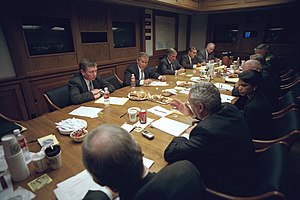Presidential Emergency Operations Center

After addressing the nation on the September 11 attacks, President George W. Bush meets with the National Security Council in the Presidential Emergency Operations Center
|
|
| Building | The White House's East Wing |
|---|---|
| Location | Washington, D.C. |
| Country | United States of America |
| Coordinates | 38°53′51″N 77°02′15″W / 38.897600°N 77.03739°WCoordinates: 38°53′51″N 77°02′15″W / 38.897600°N 77.03739°W |
The President's Emergency Operations Center (PEOC) is a bunker-like structure that lies underground, beneath the East Wing of the White House and serves as a secure shelter and communications center for the President of the United States and other protectees in case of an emergency.
Originally constructed for President Franklin D. Roosevelt during World War II, it is built to withstand a nuclear hit and is likely to be the President's evacuation point in the event of an incoming ICBM (the main protocols of escape are highly classified), invasion, terrorist attack or any other kind of emergency. It is not in the same location as the Situation Room, which is in the basement of the West Wing. However, it does possess several televisions, telephones and a communications system to coordinate with other government entities during an emergency. During a breach of White House security, to include the Washington DC Air Defense Identification Zone (P-56 airspace) violations, the President and other protectees will be relocated to the executive briefing room, next to the PEOC. Day to day, the PEOC is manned around the clock by joint-service military officers and non-commissioned officers.
During the September 11 attacks, then-Vice President Dick Cheney, Lynne Cheney, Condoleezza Rice, Norman Mineta, Mary Matalin, Lewis "Scooter" Libby, Joshua Bolten, Karen Hughes, Stephen Hadley, David Addington, Secret Service agents and other staff, including a U.S. Army major who was a White House Fellow, were evacuated from their offices in the White House to the PEOC.
...
Wikipedia
